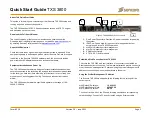
24 of 33
Calibration Diagnostics Protection:
If calibration is incomplete, the transmitter automatically
returns to normal operation and all previous calibration data
is retained. Common cause for the transmitter to refuse
calibration or for an incomplete calibration includes the
following.
Background interfering gas is
present.
If interfering gas is present
during zero, the transmitter
refuses to auto zero and exits
the calibration routine.
Combustible
&
toxic
gas
sensors:
Wait
for
the
transmitter
to
return
to
normal operation. Then apply
pure air (Zero gas) and repeat
calibration process.
Calibration gas cylinder runs
empty during the calibration
Wait for the transmitter to
return to normal operation.
Replace the empty gas cylinder
with a full cylinder & repeat
process.
Calibration gas concentration
is too low or too high.
Calibration gas concentration
is not within expected range
–
either the concentration of
applied gas (in ppm, %
LEL or
% V/V.
) is too high or too
low.
The transmitter refuses to set
span if the calibration gas is
not within the expected range
and exits the calibration
routine.
Change the value equal to the
calibration gas concentration
being applied & repeat the
process.
Gas applied at wrong time.
Gas
is
applied
before
requested to do, or if gas is
applied
during
zero,
the
transmitter
refuses
to
proceed & exits calibration
routine. The prior auto zero
will be retained.
Restart
the
calibration
routine and apply gas, only
when the LCD/OLED display
prompts for it.










































